Bishkek Guide
Bishkek Guide
Bishkek center area is situated between the Ala-Archa and Alamedin rivers that intersect in the north side of city with the Great Chuisky Canal (Chui is the name of the region). Formerly Pishpek, then Frunze and since 1991 Bishkek (in Kyrgyz a stick to stir the mare’s milk), is the largest city and the capital of Kyrgyz Republic and is located just north from the high snow capped peaks of Ala-Too range that are part of the Tien Shan mountains. The mountains can be also seen from almost everywhere in the city by just looking towards south. Bishkek is not the most beautiful or the cleanest of capitals but it has a relaxed feeling to it with great nature around it to be explored and can offer a lot for sightseeing.
Bishkek is a Soviet-built city with wide boulevards and developing high-rises (no that high though due to earthquake risk) of around 1 million residents. The cozy, green and slightly cosmopolitan capital of Kyrgyzstan offers an exciting experience for travelers with the nearby nature destinations and the laid-back atmosphere combining vibrant nightlife and nomadic traditions.
Bishkek has lately turned into being a town for backpackers, cycle tourists, and young expats due to the low cost of living and especially due to the liberal visa regime for most countries. Most of our Kyrgyzstan tours also start and end in Bishkek and the Central Asia Tours also include a day in Bishkek.
Bishkek Guide Table of Contents
History of Bishkek
The first mentions of Bishkek were from 1825 when the Kokand fortress of Pishpek was founded here. Pishpek was established to protect caravan roads transporting goods between Tashkent and Lake Issyk-Kul across the Chuy Valley. In 1860 Russians arrived and after a battle between the Russian tsarist army and the Khanate of Kokand the fort was destroyed and taken over by Russians. By April 1878, the country’s administrative center was transferred to Pishpek, and the village received the status of a city.
Nowadays the ruins of the Pishpek fortress, which is also often called the Blacksmith’s fortress, can be found a little bit north of the new Bishkek main mosque (Turkish mosque) and the Jibek Joly street (Silk Road street). The ruins have almost nothing resembling a fortress and appear more as a pile of mud squeezed between the houses and it is evident that there have been more modern houses also built on top of it that are also in ruins now. According to some sources, the fortress was bulldozed by the Russians.

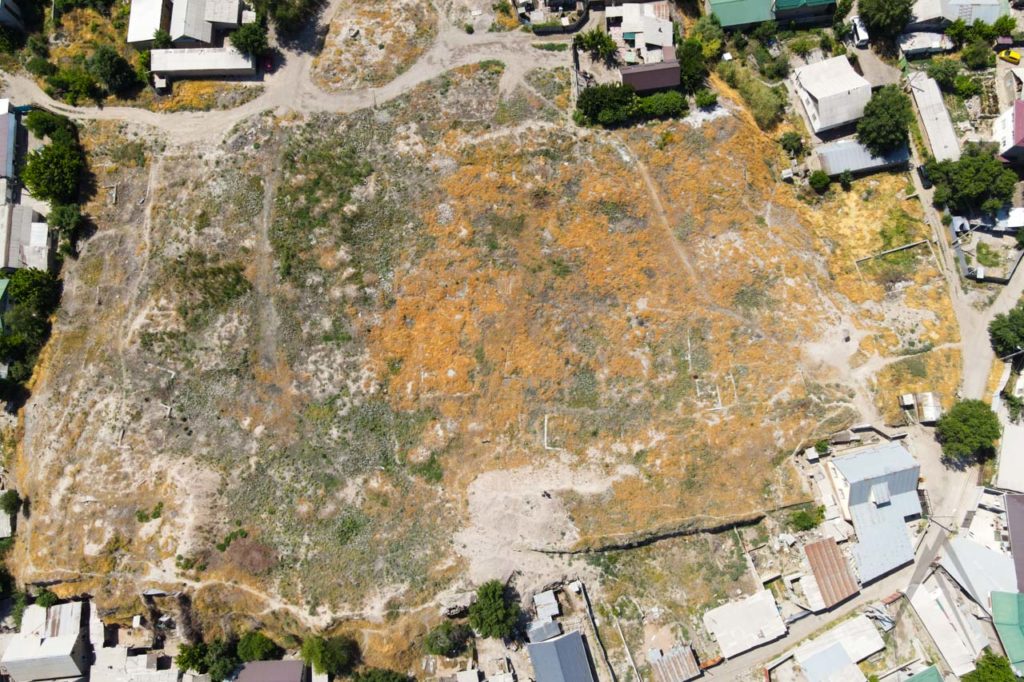
After the October Revolution of 1917, the rapid development of the city began. Pishpek was renamed Frunze in honor of famous native Soviet military leader Mikhail Frunze. In 1936, the city became the capital of the Kyrgyz SSR. The city went through good and bad days in the middle of the 20th century.
In the 1930s the Soviet Union transferred some of its heavy industries to the Kyrgyz Republic to hide them away from the German attacks and this improved the city’s economy. However, the economy also took a hit when a big number of intellectuals in Frunze were persecuted due to Stalin’s purges until the 1960s.
During 1970 to 1980 a number of soviet buildings in Bishkek were built due to the first secretary of the republic called Turdakun Usubaliev, who ordered the construction of the impressive marble buildings that still stand in the city center, including the National History Museum and the houses on Ala-Too Square.
Following the collapse of the USSR and gaining independence in February 1991, the city was renamed Bishkek. Since independence, Russian influence over Bishkek has declined, allowing Kyrgyz to add their own decorations to their capital. The decorations involve for example Kyrgyz traditional ornaments and murals by Kyrgyz artists on many of the city’s latest housing blocks. Most of the Soviet statues in Bishkek have been also replaced by statues of known Kyrgyz people of the past or characters from folklore and legends, except for the large Lenin that was just moved behind the national museum. The new buildings in the town have often also a hint of East in their architecture.
What to See in Bishkek
Bishkek is a compact city and one or two days is enough to see the main parts that it has to offer for sightseeing that are concentrated around the area along the Chuy avenue. Having said this we want to emphasize that Bishkek is still a good base camp to explore the whole of Northern Kyrgyzstan. From the Chuy main street and almost everywhere in the city you can see snow-capped mountains to the south (if there is not too much smog in the air that is). Be aware that the locals usually refer to north as down and south as up since the landscape is constantly decreasing in level as moving north inside Bishkek. The city architecture offers a glimpse of the Soviet influence mixed with some Islamic and Eastern sights.
Walking in the cozy boulevards you can see marble-faced public buildings combined with numerous Soviet-style apartment blocks and a number of beauty salons. The most common profession for young Bishkek ladies seems to be a manicurist, make-up artist, or eyelash specialist.
Bishkek Ala Too Square
The central square was built in 1984 to celebrate the 60th anniversary of the soviet republic of Kirgizia. Formerly known as a Lenin square, today the Ala-Too square is a place where locals enjoy walking around, celebrating concerts and festivals, or organizing meetings and demonstrations. It is also the center of Kyrgyz culture with Kyrgyz and Russian drama theaters, operas, cinemas, and libraries in the Soviet-style, all located nearby.
Behind (north) the open square, dotted with fountains, there is the National Historical Museum, which was opened again in late 2021 after being closed for about 5 years due to renovation. At the backside of the National History Museum, you can find a large Lenin Monument which was moved to its current place in 2003 from a more central location and being replaced by a more appropriate Kyrgyz horse statue.
North-east from Alatoo square, there is a beautiful Oak Park known as Dubovyi Park. This park is the oldest park in Bishkek and is filled with old oak trees, Kyrgyz-style sculptures, and fountains. West of the Oak Park, the amusement park Panfilov is a favorite place for kids with numerous attractions and games.
Behind theNational history museum, there is an old square where you’ll find the parliament building. Frunze Museum, a medium-size museum dedicated to the life of Mikhail Frunze, is located next to the parliament. Mikhail Frunze An important figure in Kyrgyz Soviet times was born in 1885 in Pishpek.
He was a celebrated Bolshevik General and a close associate of Lenin. To honor his death his hometown was Frunze.
In 2011, a statue of the hero of the folk epic Manas was erected in front of the national history museum with his bronze figure reaching the height of 10 m. During the same year, two other significant monuments were placed as well. At the Southern edge of Ala-Too Square, there is a monument to Chingiz Aitmatov (the best-known author in Kyrgyzstan’s literature). Next to the Manas sculpture, a monumental flag is guarded by the honorary guard who changes shifts every two hours. You can catch the sharp moves and the synchronized march of the guards that were originally adopted by Russia and modified by the Soviet Union into what it is nowadays.
Little further from Ala-Too square next to the white house (president’s house), there is a monument to Those Who Died in the Events of 2002 and 2010. It was made of two massive stones, one black and one white, with a group of people pushing the black stone away from the white. This memorial is dedicated to those who gave their lives in Aksu in 2002 and in the revolution in 2010 for a better future for Kyrgyzstan.
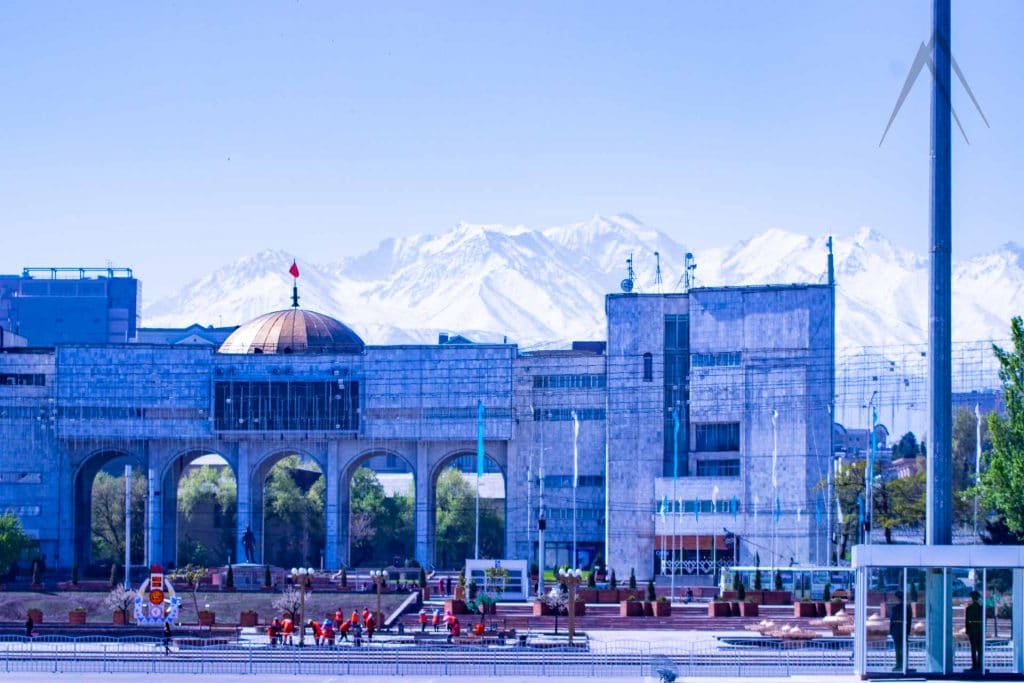

Bishkek old Square
The old main square of Bishkek lies to the north of the main Ala-Too Square. It used to be the main Central Square called “Red Square” but is now “behind” everything. The old square occupies a big area with two major buildings, the Parlament (Jogorku Kenesh) and the Supreme Court of the Kyrgyz Republic.
During the Soviet time, the current Supreme Court building belonged to the Central Committee of the Communist Party of Kirgizia. There are still the bronze statues of chatting Karl Marx with Friedrich Engels just in front of this building. Behind the Supreme Court you can find a Frunze museum, which is dedicated to the life of prominent Soviet commander M.V. Frunze, who also gave the city its name during the Soviet era. The Kyrgyz State drama theater is located opposite Jogorku Kenesh (Parlament building) and in the west the old square is limited by the amusement park called Panfilov park.
Erkindik Avenue
Erkindik avenue goes back to 1902 when the colleagues of the horticulturalist M. Fetisov planted trees along the street. Most big cities have streets that are loved by all citizens which and reflect the soul of the town. In Bishkek, it is the Erkindik Boulevard, formerly Dzerzhinsky Boulevard and locals therefore still sometimes call it Dzerzhinka.
The total length of this green boulevard is 2,2 km, it stretches from south to north from the Bishkek railway station until Zhibek-Zholu Avenue. There are many restaurants along it accompanied by ice cream trucks and other entertainment facilities during the summertime. Local couples often sit in the many benches of Erkindik boulevard in the evenings and many seek shelter from the heavy sun during the day time under the canopies of old oak trees.
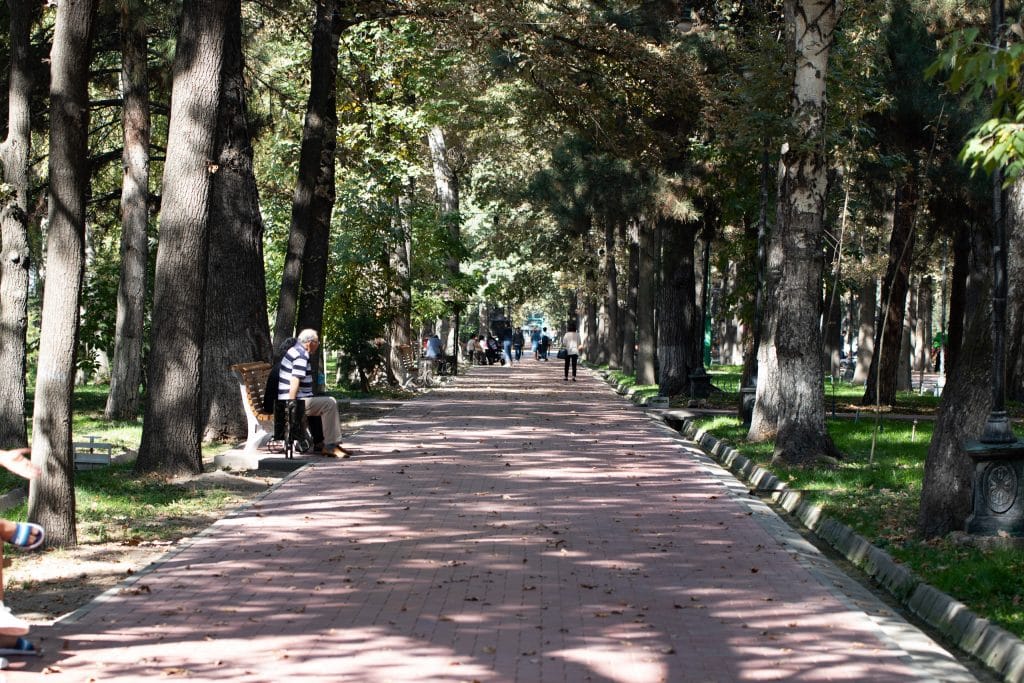
Bishkek Art street
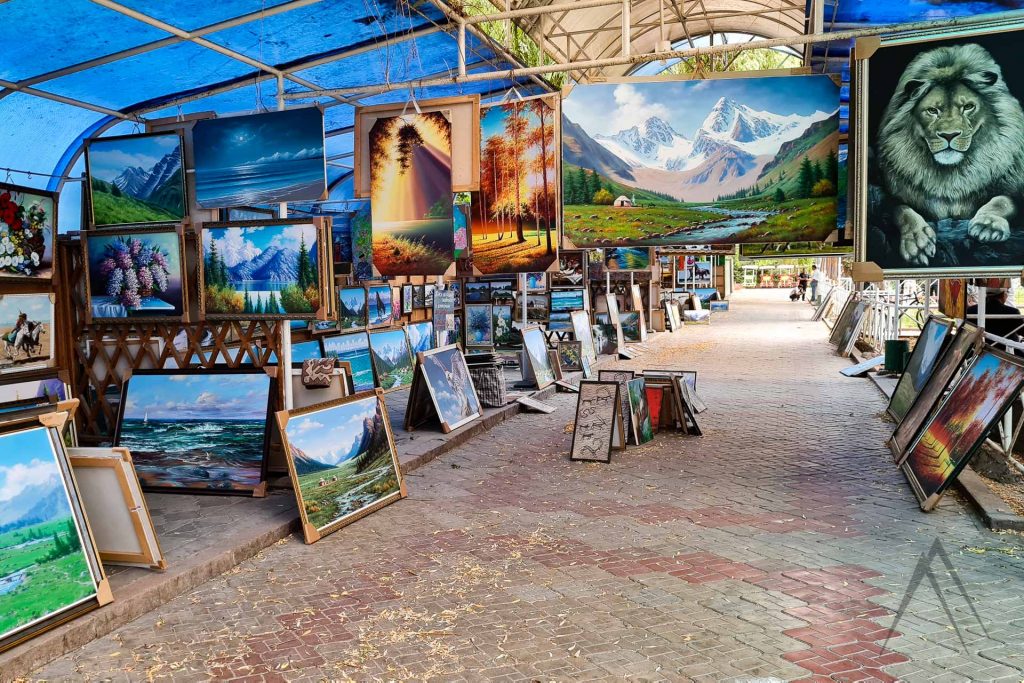
At the end of Erkindik Avenue is the local Arbat, a street for the selling of paintings. Here artists exhibit and sell their paintings of mountains, horses, and portraits mainly local themes. Sometimes you can find some real gems in here.
Bishkek White House
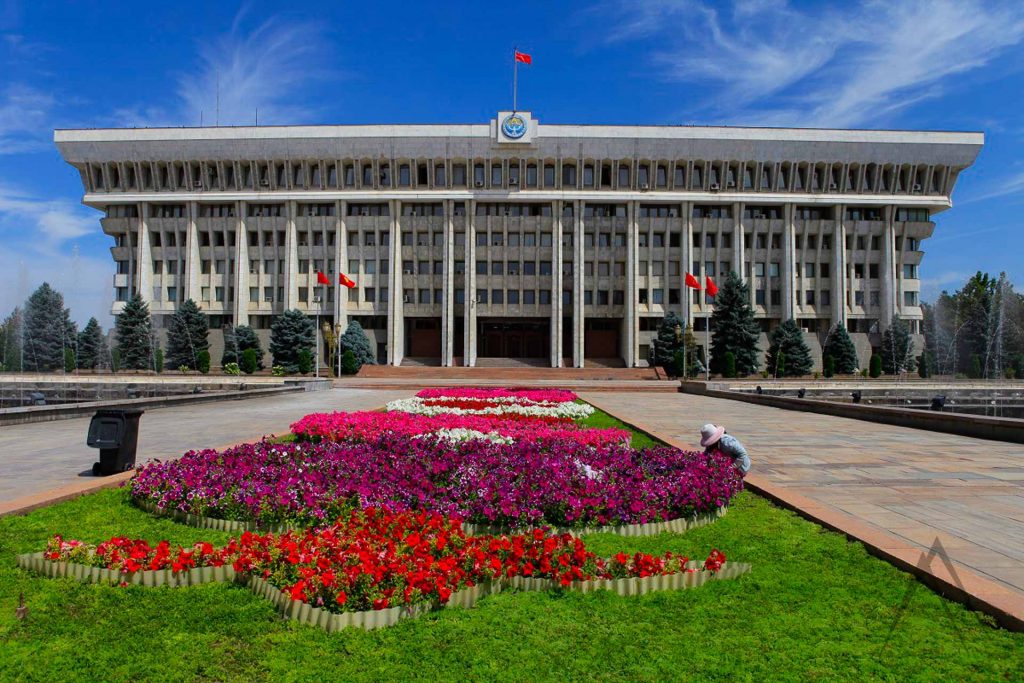
White House or the Presidential Palace located just next to the Ala-Too square. The fence around the building was installed during the presidency of first president Askar Akayev, who now in Moscow. White House has seen three revolutions and its fences got legendary after the pictures of climbing people during the revolutions. The fences were demolished by the order of the current president except for a small piece with a plaque to remember the victims of uprisings.
Bishkek Victory Square
Another must-visit sight in Bishkek is the Victory Square located in the Northeast part of Bishkek center. In the square there is a statue of a woman waiting for the loved ones to return home from battle.
She is facing north, the direction in which the men went off to fight in the WW2, under three granite half-arches that represent the supports of a yurt (a traditional Kyrgyz nomad tent).
The crown ring where the supports come together, is in the shape of a wreath with the Soviet star inside. The eternal flame sits at the woman’s feet. The flame in the middle never goes out and often you can see newlywed couples and young friends taking pictures next to the fire. (And some homeless people warming up during the cold winter nights).
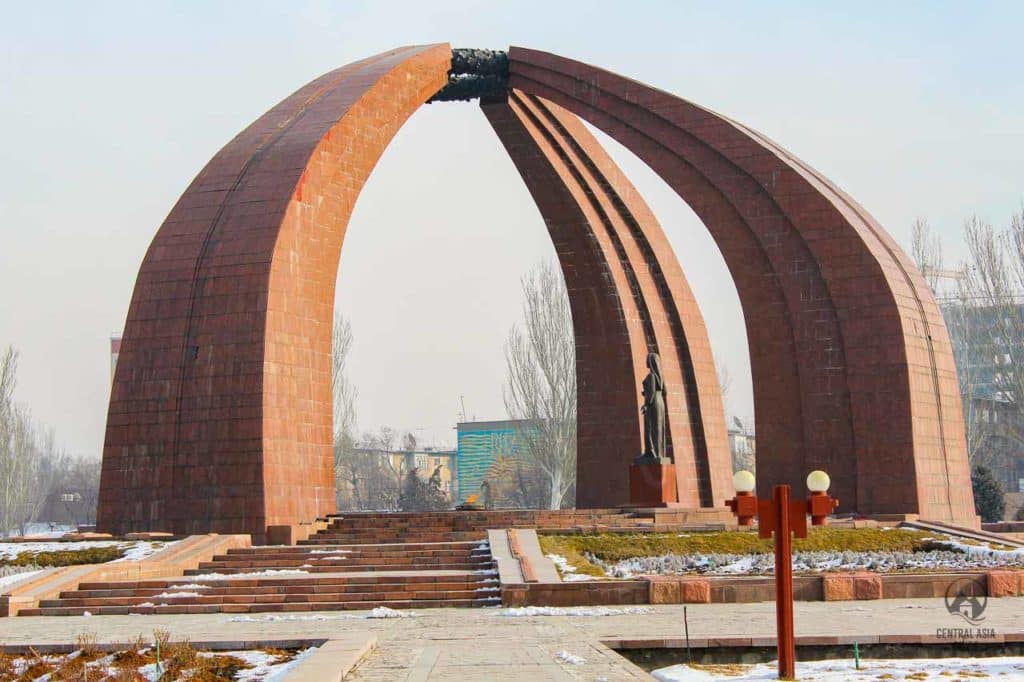
Kyrgyz National Philharmonic
Kyrgyz National Philharmonic is located in the center of Bishkek, on Chui Avenue, surrounded by a public garden, the snow-white buildings of the Bishkek city hall, Institute of Mining, International University of Kyrgyzstan, and Philarmonic itself.
In the courtyard of the Philarmonia situated a monument of Manas, the hero of the epic Kyrgyz poem along with a sculpture of Kanykei his wife and adviser Bakai surrounded with fountain. Residents and guests of the capital enjoy the coolness from the fountain, the foamy streams of which glisten and sparkle in the sun. And there is a long alley in the east side of Philarmonic designed with the beautiful flowers which leads you all the way to the Kyrgyz National University.
The Kyrgyz National Philharmonic is named after the composer, music virtuoso, akyn Toktogul Saltyganov. Since 1980 the philharmonic has offered high-quality entertainment to the people of Bishkek, including symphonies and Kyrgyz orchestral musical performances. Inside of the Kyrgyz State Philharmonic there are two separate halls and hosts a wide variety of concerts, from classical to traditional Kyrgyz to modern pop.

Rabochiy Gorodok
“Rabochi gorodok” translates as the workers town and is a district located on the southeast side of Bishkek. This district emerged in 1920 and developed according to the concept of the English architect E. Howard. Primarily it was an attempt to create a “garden town” in Bishkek. There is supposed to be a park in the center with four concentric circular routes around it and twenty-four radial roads which divide the town blocks.
Bishkek Panorama
You can see the city in the palm of your hand in the panorama. The view of the green city opens up from an easy-to-view point from a hill at the south side of Bishkek at the Chon-Aryk hill like Kok-Tobe near Almaty.
However, a comparison of the two mountains clearly explains the difference between Kazakhstan and Kyrgyzstan. While in Kok-Tobe there is an amusement park, a TV tower and a cable car but at Chon-Aryk there are only pastures, graves and empty plastic and vodka bottles with a bad road leading to it.
Kyrgyz National Opera and Ballet Theatre
Opposite of Museum of Fine Arts, next to the Hyatt-Regency Hotel are the Kyrgyz National Opera and Ballet Theatre named after Abdylas Madumarov. He was a Kyrgyz composer, actor, and operatic tenor singer.
The theatre is a beautiful building with columns and carvings. If you wish to see an opera or a ballet, check out the upcoming events through the Opera and Ballet official site.
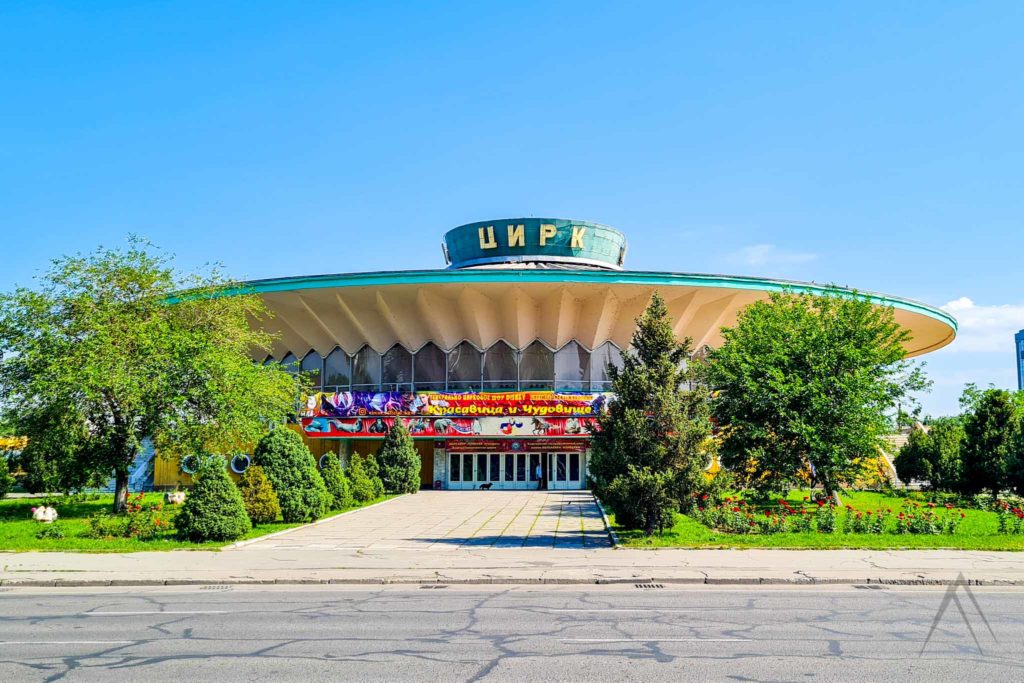
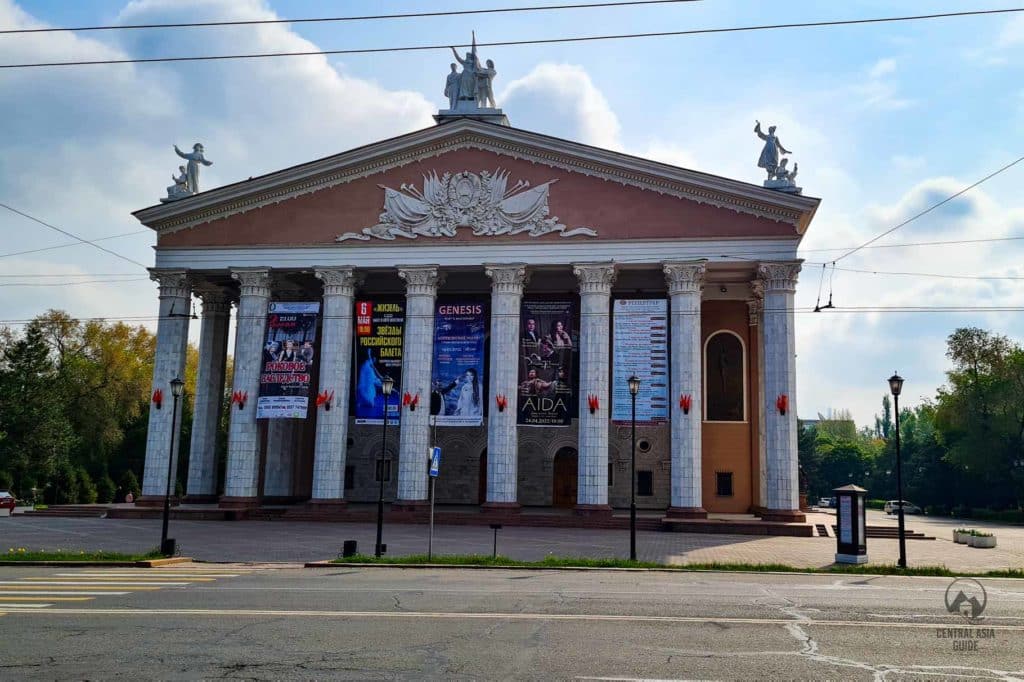
Bishkek State Circus
One of the many attractions in Bishkek is the State Circus located on Frunze Street. It was built in 1976 by the famous architects L. Segal, B. Shardin, A. Nezhurin and D. Leontovich. The first circus performance was held in 1978, with the participation of the best acrobats, magicians and trainers of Kyrgyzstan.
In 1995, in the arena of the Bishkek State Circus, they showed a performance called “Lion Tamers”, which received recognition far beyond the borders of Kyrgyzstan. The Bishkek State Circus underwent a significant renovation that was completed in late 2024. For information on current shows and ticket purchases, visitors can refer to local ticketing services such as Ticket.kg, which provides details on upcoming events and seating options.
Bishkek Museums
Kyrgyz State Museum of Arts
Next to the Oak park, you will find the Kyrgyz State Museum of Fine Arts named after the Kyrgyz artist Gapar Aitiev.
The museum exhibits some of the finest pieces of artistic grandeur of Kyrgyzstan and the region. Today it is also the venue for many contemporary exhibitions.

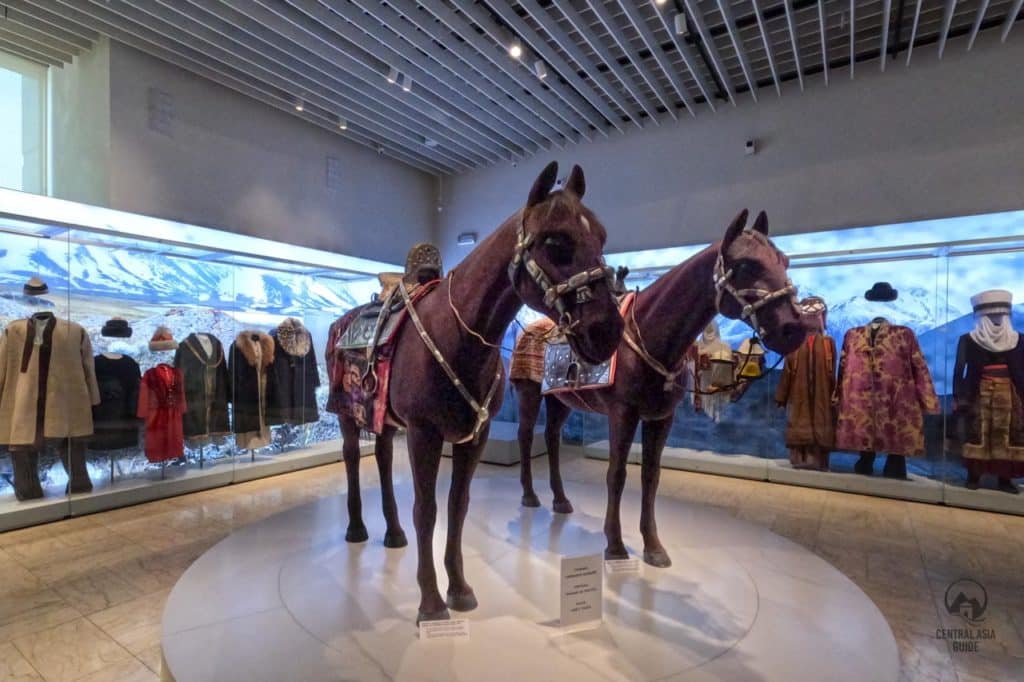
Frunze Museum
The museum traces the life and career of Mikhail Frunze in a house that is allegedly the house in which he was born and brought up in. Frunze was a successful Soviet politician and army officer born to a Romanian – Russian family and as a token of his success, Bishkek was named after him 1926 – 1991, after his death until the independence of Kyrgyzstan.
The Frunze museum house is a typical representative of it’s time (1879) with lots of objects related to Frunze himself and his political and military career. The museum also housed a temporary exhibition telling about the history and development of Bishkek and the changing exhibitions have been updated almost yearly for the last few years.

National History Museum
Bishkek national history museum presents a cross-cut of Kyrgyz history from the pre-historic era to the days of independence and especially the ancient and medieval sections of the museum are worth seeing. One section of the museum is dedicated to valuable old jewelry that has been found from different parts of Kyrgyzstan.
Before the renovation, the museum housed an amazing amount of artifacts from Soviet Union. It has been said that a vast amount of the old objects vanished during the renovation of the museum.
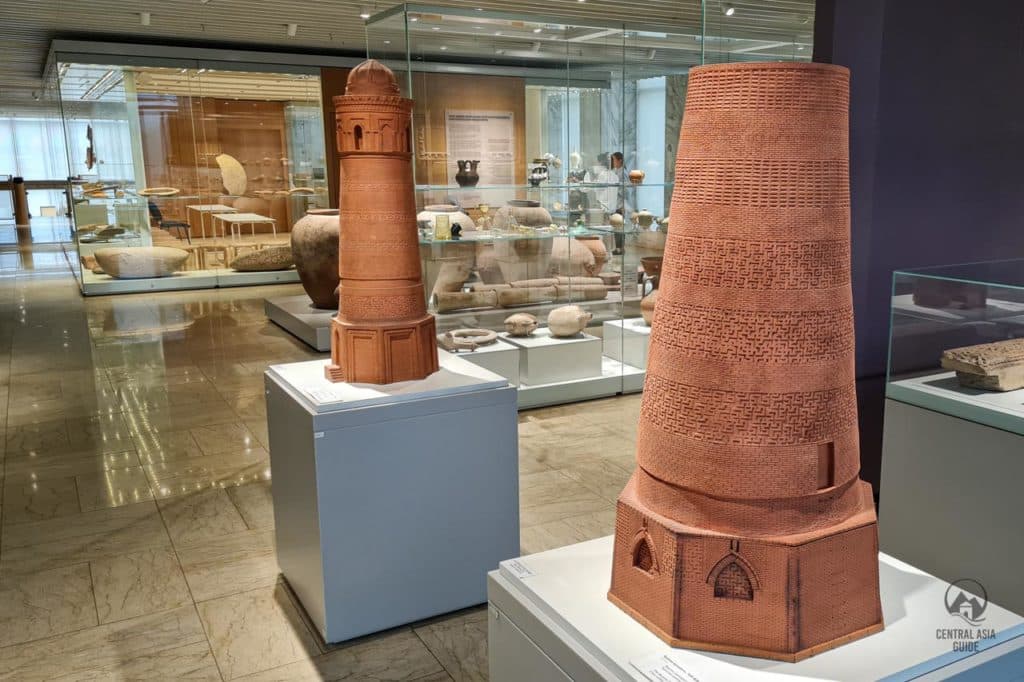
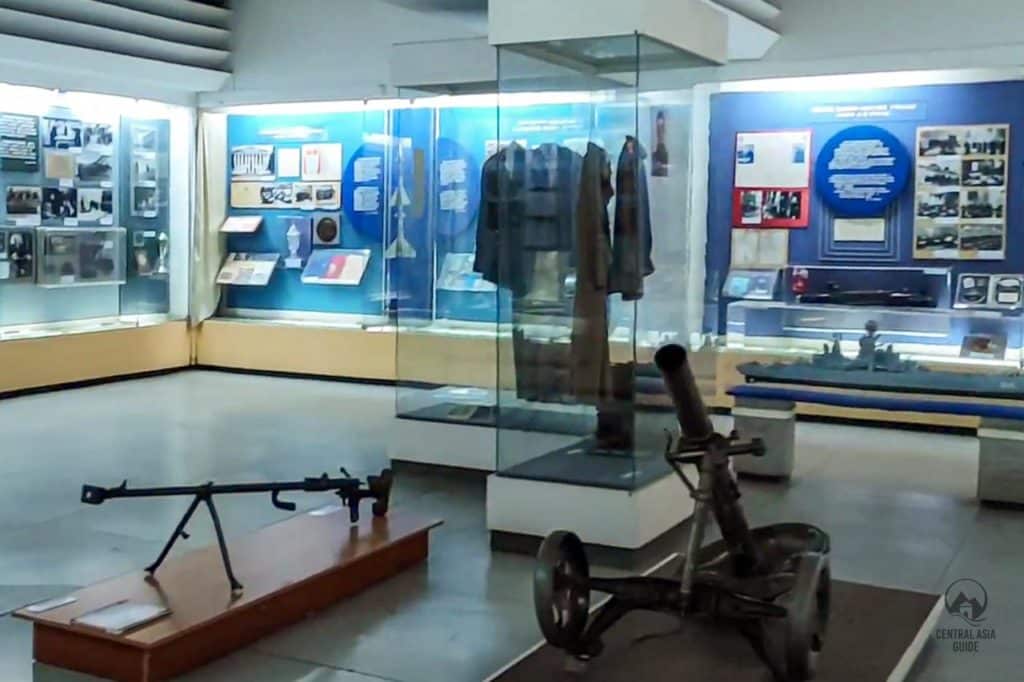
Other museums in Bishkek
Surprisingly, Bishkek has many many museums but most of them are not well known: Tinibek Sadykov Museum, Aaly Tokombaev Museum, Gaspar Aitiev Studio, Semeni Chuykov Museum, Toktugulok Literary Museum, Mineralogical Museum, Zoological museum (recommended if you are interested in Kyrgyz fauna), National Bank Museum, National Library and few more that are closed for renovations.
Central Asia Tours including Bishkek
What to Do in Bishkek
Bazaars of Bishkek are a favorite destination among the travelers: Osh bazaar, Orto-Sai bazaar, Alamedin bazaar, and Dordoi bazar, which is the largest in Central Asia. Bazars of Bishkek are diverse, large, colorful, crowded and you can find pretty much anything there. Closest to the center is the Osh bazar in the Western part of the city and it is a big open air market with some smaller closed inside areas.
The crowds, the smells, and the noises inside can make you a bit overwhelmed the first time you enter. Keep on eye on your valuable items, because bazaars have a reputation of pickpocketing. Ak Emir bazar is a smaller bazar just little bit East of the city center offering mostly good quality fresh fruits, vegetables and meat products. Some could called it a high end grocery bazar of Bishkek.
Mal Bazar is a livestock market popular in autumn. During the autumn time the animals are well fed from the fresh summer grass and are just back from the pastures. Autumn is also the wedding season and giving horses, sheep, or goats is considered a respected gift. In Kyrgyzstan, like in many other Central Asian countries, families spend a lot of money on weddings and other celebrations.
Visit Bazars of Bishkek
Bishkek Entertainment
Bishkek Shopping Malls
Bishkek has big shopping malls such as Tsum, Dordoi Plaza, Asia Mall, Vefa Center and Ala Archa mall with tons of stores, cinemas, supermarkets, playgrounds as well as food courts. They places where young locals to go hang out with friends or family. Quite many of the shops sell Chinese origin items and you cannot always be sure if authentic looking shops are the real brand shops or not.
If you are looking for souvenirs, head to the 5th floor of Tsum or Tumar at the corner of Isanova and Kiev streets. The latter one mentioned is rather expensive but they also sell very good quality products.
Bishkek offers a variety of cuisines
For the food lovers Bishkek offers a variety of cuisines from around the world in addition to local kyrgyz cuisines. From Georgian to Thai, from Korean to Mexican, just name it. Chinese cuisine is very popular within the locals and there are plenty of Chinese restaurants with a variety of quality and price but generally the Chinese food is tasty in Bishkek.
If you get hungry in the middle of the night you can walk to the nearest supermarket or pharmacy as they mostly work 24/7. Moreover, food delivery services are very popular in Bishkek at affordable prices and can really save your hangover or just an otherwise lazy day.
Bishkek Spa & Sauna (Banya)
Spas are very popular in Bishkek and there are various types of spas with different price ranges from modest to luxurious. Locals usually go to spas to spend the entire day with their friends and families, enjoying the services and to eat and drink well. In Bishkek, the spas are always separate for men and women.
Generally, most spas offer a wide number of saunas like Finnish sauna, Russian sauna, Turkish bath called Hammam and a national style sauna. Better places also offer a steam cabin, hot tub, pool, cold cascade shower, relaxing room with TVs and so on. Men and women bath mostly separately and in the women’s side there is usually a good choice of inexpensive beautification procedures.
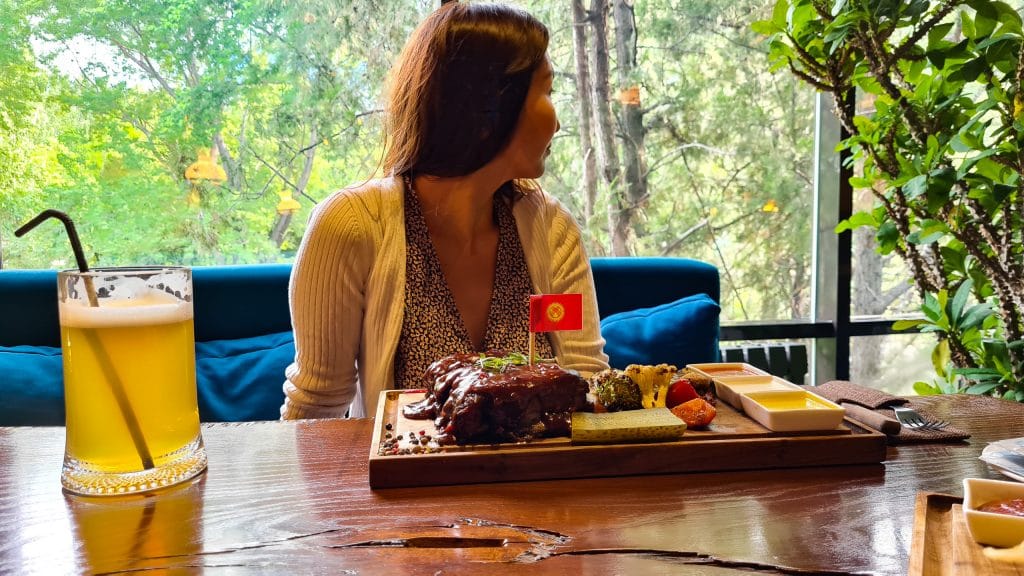
Bishkek Movie Theaters
There are several cinemas around Bishkek and some of them even offer movies in English or at least with English subtitles. Check here for more information: https://www.facebook.com/englishmovieclub/
Bishkek Coffee Houses
The number of stylish coffee shops in the city of Bishkek is increasing every day. Drinking coffee among the townspeople has become a fashionable habit, apart from just drinking coffee the coffee shops turned to thee freelancer offices. Due to the number of coffee shops, the choice of a coffee shop depends on the purpose of your visit: a stronger coffee to tune in to the working day, a business meeting, or chat with friends. In Bishkek, the average bill per person is from 200 to 1000 som.
Bishkek golf club
There is a golf club at the outskirts of Bishkek, close to the village of Ala Too, towards the first hills of the Tian Shan mountains. There are 9 holes to play and good restaurant and alcoholic services.
Bishkek Night Life
Bishkek is a hub of nightclubs and bars where one can have an amazing nightlife experience. Also, there are bars popular within expats, where they gather to watch a football match and enjoy live music. There are different type places for every taste and the prices are quite affordable especially with the local beer products and snacks. Try the cold smoked fish with beer! The quality of internationally known drinks varies a lot and is better in the high end places. Lately shisha bars (tobacco for smoking in a hookah or bong, usually mixed with flavors such as mint) have been getting very popular.
Travel to Bishkek
Bishkek by Plane
There are many international flights to Bishkek. If you are coming from Western countries you may take Turkish Airlines flights through Istanbul taking about 5h 30m. Flights from Moscow with Aeroflot take about 4 hours. Due to large amount of Kyrgyz workers in Russia the other major cities are also well connected to Bishkek.
If you are arriving from elsewhere in Central Asia, you can take Astana airlines through Almaty or Astana taking about 55 minutes or 2,5 hours to Bishkek or Uzbek Airways from Tashkent taking 1h 15 minutes. Fly Dubai also offers inexpensive flights from Middle East direction.
Bishkek by Train
There are direct train routes with Moscow through Kazakhstan and an indirect one in Tashkent in Uzbekistan that also travels first through Kazakhstan.
The journey from Moscow takes about 73 hours. Within Kyrgyzstan, only few routes operate, between Bishkek – Balykchy (only summer time for Issyk Kul visitors) and Bishkek Kara-Balta.
The Bishkek Train station is located south of the city center at the junction of Erkindik Boulevard and Lineinaya street.
Bishkek by wheels
From Almaty, Kazakahstan you can get to Bishkek by marshrutka or taxi in four hours, the trip being 240 km in total. Minibuses and taxis to Bishkek depart from the Sairan bus station. Marshrutka will cost you 250 som a seat and taxi 400 som a seat. Yo can also take a taxi till the border and travel rest of the way from the Kyrgyz side with marshrutka or by another taxi. (Not all of the taxi drivers are willing to cross the border)
There is bus line between Tashkent, Uzbekistan and Bishkek. Traveling between the two cities by bus takes about 8 to 13 hours depending on the border crossings and the road conditions. The cost of a bus ticket is about 1500 som.
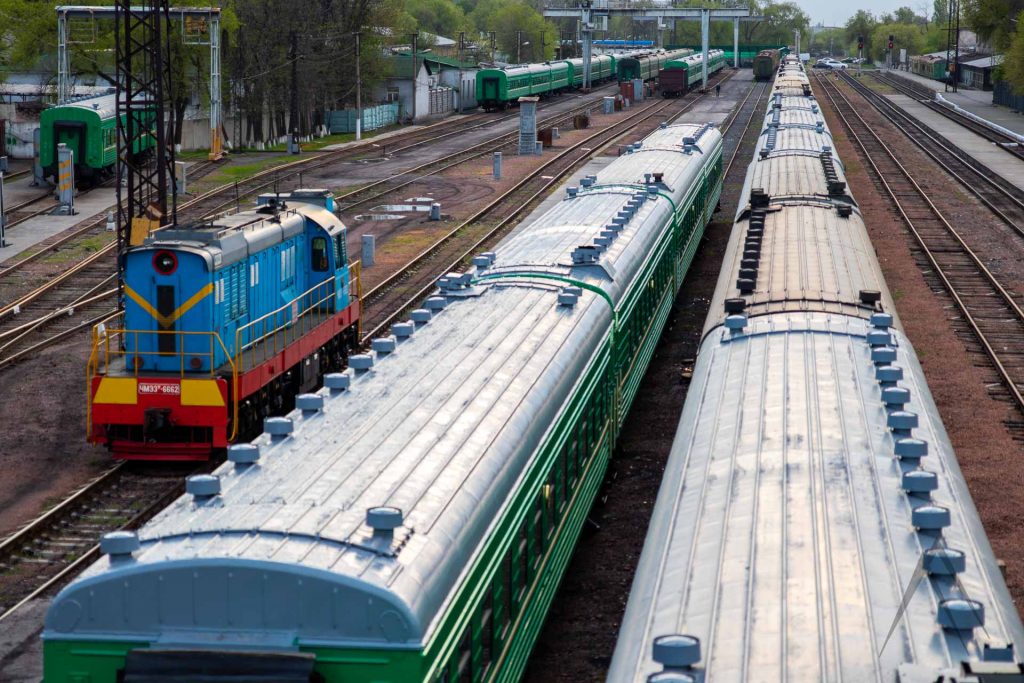
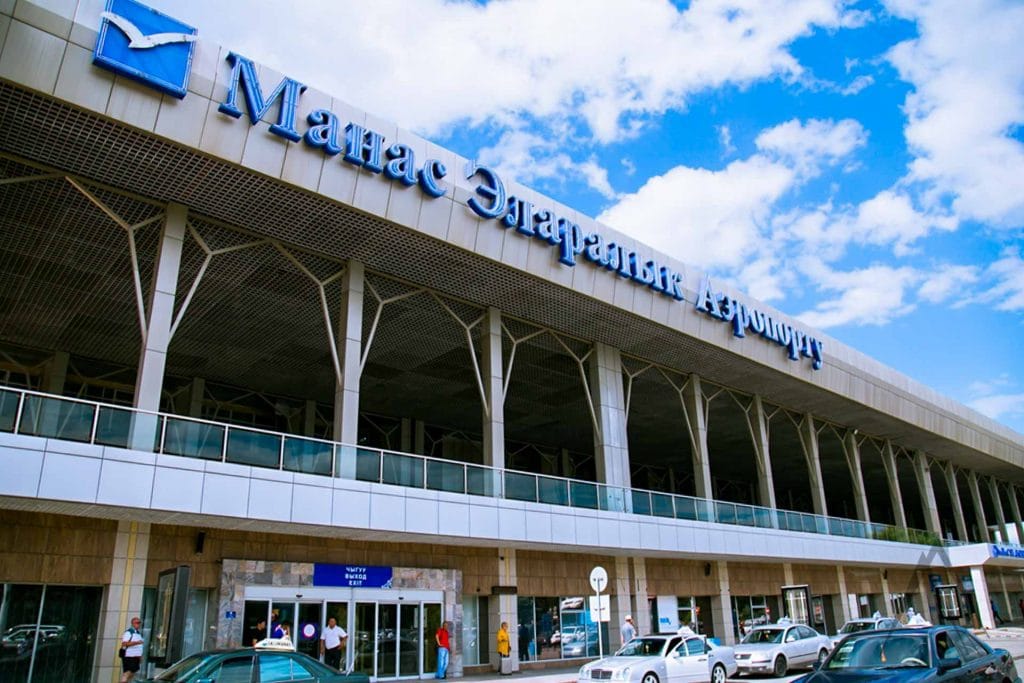
Bishkek Manas Airport
Manas International Airport is located about 30 km Northwest from Bishkek city center. At arrival, you might meet some enthusiastic taxi drivers that will offer you a ride to Bishkek. The most eager ones grab your bags and guide you straight to their car and will most likely charge you more than the standard price which is about 600 som. Most hotels usually offer the pickup with an extra cost but it saves you from most of the hassle while arriving. If you want to get a taxi from the airport, the most convenient one is the Manas taxi that have their own counters at the airport and usually English speaking persons present in the counters.
There is a shuttle marshrutka (Aero express) service but it is not continuous and often not available at the time of arrival of international flights. When available, it costs about 120 som per person. Marshrutka 380 also goes to the airport and operates from 7.00 until 21.00 price being only 40 som. When leaving Bishkek it is recommended to organize the taxi ride to airport beforehand as during rainy days or other disturbances it can take a while to catch a taxi. Booking beforehand can be done via the apps of Manas taxi and Yandex taxi.
Taxis in general inside Bishkek and for nearby destinations are half or 2/3 price if you use the apps compared to the taxis straight from the street. Apps always have standard meters so it is always a fair deal. If you take taxis from the streets it’s better to negotiate the price for the destination first to avoid haggling after the trip is already done. Taxi is generally the most convenient way of moving around in Bishkek. Marshrutkas can get very crowded and trolley buses or buses are not available everywhere. Especially during rainy days the city traffic can be quite heavy and you might end up sitting in one street for a long time.
Where to Stay in Bishkek
Bishkek offers a variety of choices depending on the preferences of travellers, from low-price hostels to fancy hotels in the city centre. You can find great hostels for 30$ located in the centre. Lately, Airbnb has gotten more popular and depending on your taste, you can get cosy room or comfortable apartment for an affordable price through the service.
For the people who like to pay more, there are good options of five-star hotels such as Hyatt and Orion, which include saunas and swimming pools with other services as well. If you have adequate skills in Russian, it is also not a bad option to browse the forums where people rent their apartments for longer periods.
Getting Around in Bishkek
The central part of Bishkek is relatively small and one can get around here by foot quite well. However, for longer journeys to the outskirts of the city or journeying across the center at the night, it is best to get a taxi or to use the city’s public transport services. Public transportation in Bishkek includes buses, trolleybuses, marshrutkas, and taxis. There is a useful application for public transportation routes called “bus.kg” which has a Bishkek route finder app that you can download.
Many cars seem to have AC but almost no one uses them and an even a lesser group of drivers maintain them. The driving culture in Kyrgyzstan is different and if you decide to drive then you should be ready for bad roads and deal with an aggressive way of driving. Outside Bishkek, it is easier to drive also for Europeans but inside Bishkek, only the bravest ones are willing to try.
Bishkek Bus
The most popular form of transportation among the locals is used to be the marshrutka until they were banned in the Bishkek city area in 2024. Now, marshrutkas travel only between Bishkek and long-distance destinations. Moreover, trolleybuses were also replaced by new buses,
The new buses are designed to accommodate more passengers, including those with disabilities. However, strollers still seem to be challenging to enter; most bus drivers still require you to fold them.
In line with the transportation overhaul, Bishkek’s main bus stations have been relocated to reduce traffic within the city. However, due to the distance, residents take more time to get there as they are now moved to the two ends of Bishkek.
Western Bus Station: Previously serving passengers heading to southern regions of Kyrgyzstan, the Western Bus Station was closed in 2024. Services have now been moved to a new terminal located in Kozhomkul village (formerly Voennaya Antonovka).
Eastern Bus Station: The Eastern Bus Station has been relocated to the Alamedin area, at the intersection of the bypass road and Alma-Atinskaya Street. It now serves as the primary hub for routes to Issyk-Kul, Naryn, and other eastern destinations.
Bishkek Taxi
Taxis are everywhere in Bishkek and it the most convenient and quickest way to get around the town (though walking a short distance can be faster sometimes during heavy traffic). There is no uber, but plenty of comfortable, safe, and low-cost taxi services that work with high-quality apps like Yandex taxi and Bi taxi, and calling taxis like Jorgo and etc. Generally, taxis in Bishkek are relatively inexpensive.
Most of the drivers do not want to use air conditioning even if it would be working due to the increased fuel consumption and mostly it does not even work except in some more luxurious taxi services like comfort taxis.
Sights Around Bishkek
By venturing 20-30 km away from Bishkek, one can find yourself already in very different surroundings like mountain valleys. You will find scenic hiking and horseback riding, interesting cultural sights, charcoal-baked trout, and fresh air to breathe. There are also other types of places to visit near Bishkek like memorials and ancient city ruins.
Ala-Archa Reservoir
Ala-Archa reservoir is combined with three reservoirs of medium size with often overgrown bottom and curving coastline. Ala-Archa is a river a tributary of the Chu River. It originates from glaciers in the area of the northern slope of the Kyrgyz ridge. High water in summer (May-September), low water in winter.
Ala-Archa flows in the Chui region through the suburb of Bishkek, the village of Mayevka, and near the village of Orto-Sai. The length of the river is 78 km, the basin area is 270 km² (according to another source, 233 km², the average water discharge is 4.17 m³ / s.
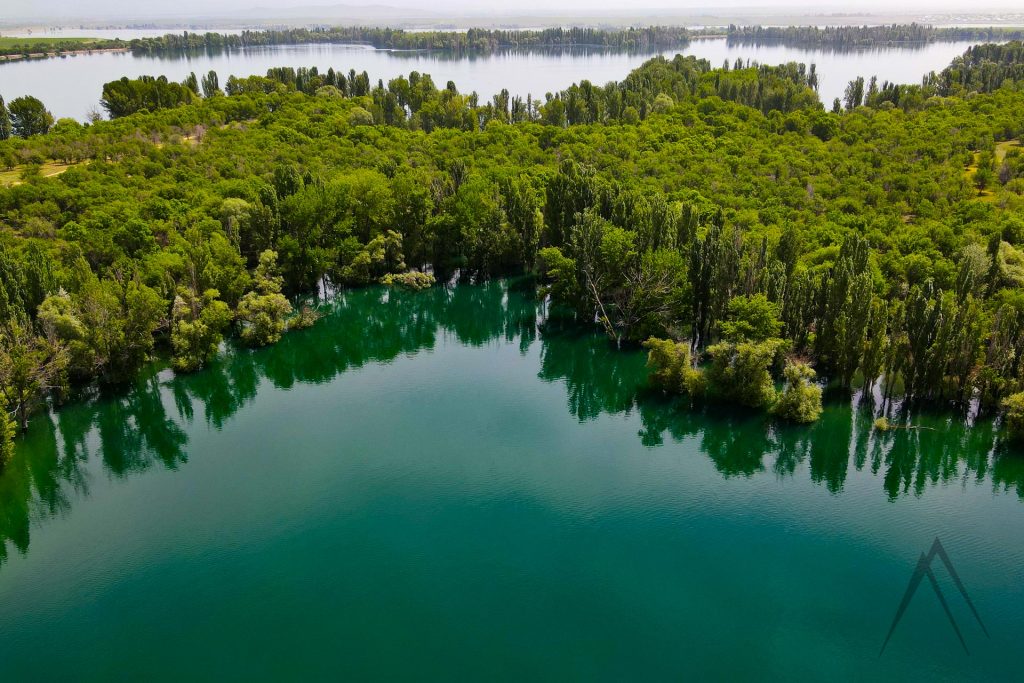
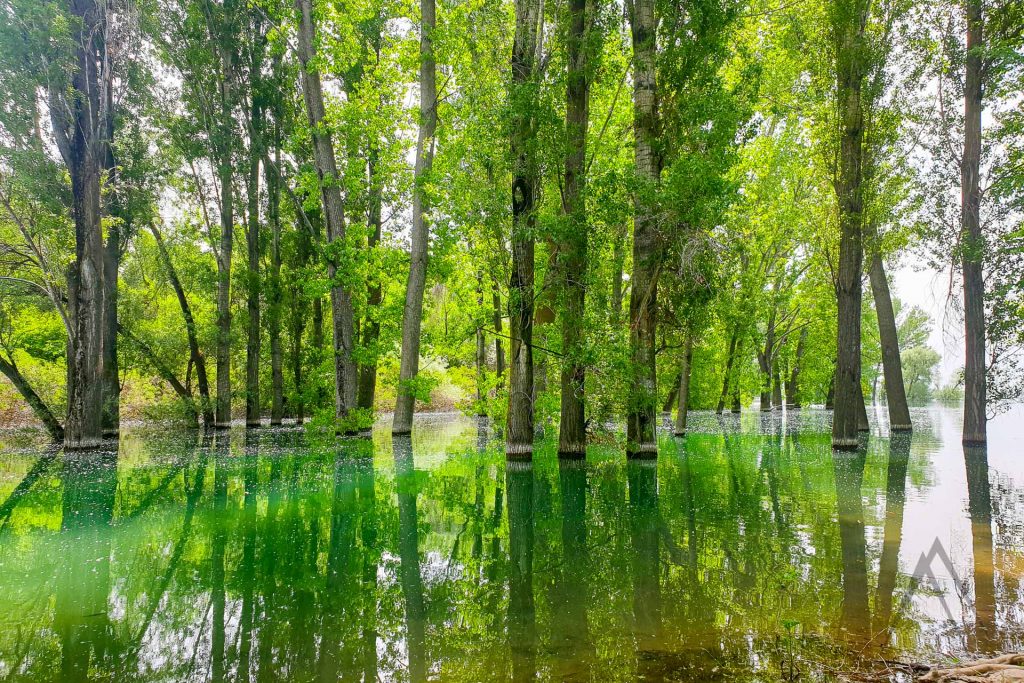
Ala-Archa, translated from Turkic, means variegated juniper. A reservoir of the same name was built on the Ala-Archa River. Many main canals emerge from it, which irrigate the vast lands of the Chui valley. Water from the river is used to fill the Ala-Archinsky and Nizhneala-Archinsky reservoirs. Also for irrigation of agricultural land using drainage canals.
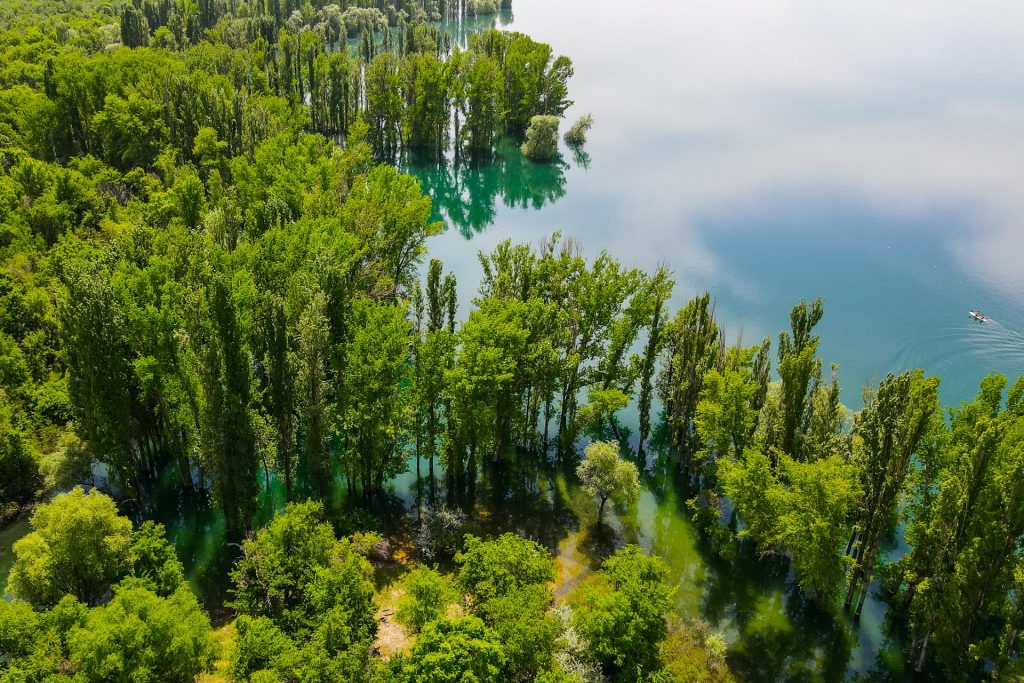
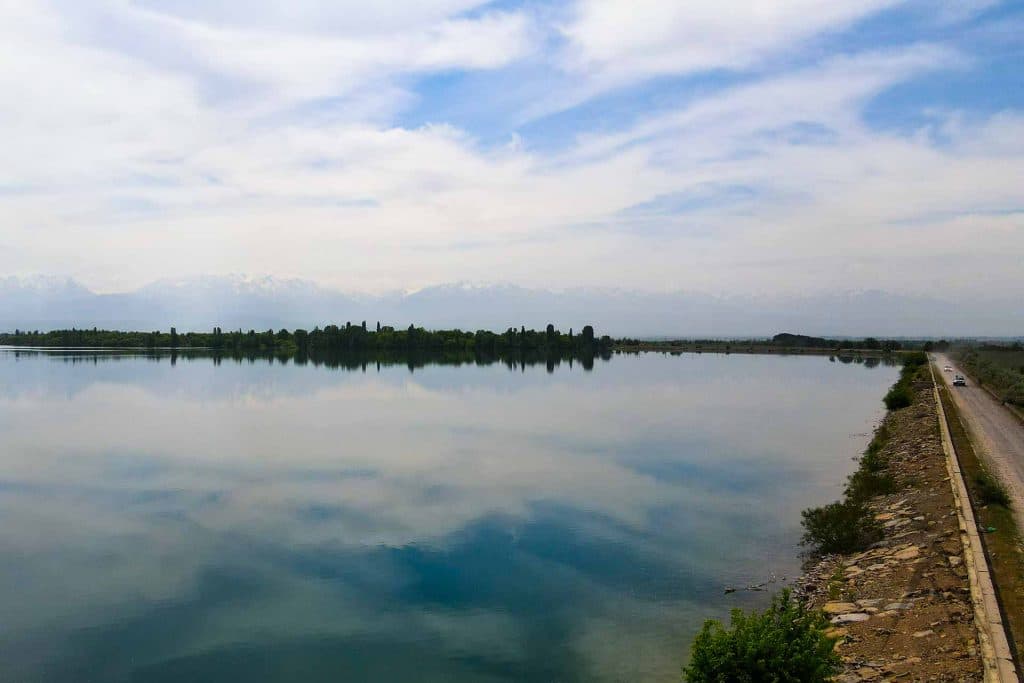
Ancient and Medieval cities around Bishkek
It is a well-kept secret that Kyrgyzstan also has many ancient or Medieval walled cities like the ones in Uzbekistan, Tajikistan, and Uzbekistan. They are just less excavated and established as tourist sites. But there is also a possibility here: They are free to be roamed and explored. One can easily see the pieces of pottery lying around and the walls and other remains of the old cities visible in many locations.
Bishkek tips:
- Watch where you step in Bishkek! There are uncovered ditches all around and sometimes there are holes in the pavement and bridges.
- Toilets all around Kyrgyzstan are mostly of the type of hole in the ground. In Bishkek, in hotels, restaurants and better nightclubs you will mostly find the toilet seats but it is not 100% certain even here.
- Air quality in Bishkek can be very bad during the winter period due to the excess burning of coal in the households and a large amount of old cars in the city area.
- Take some time to relax and enjoy the basic amenities of life in Bishkek as when you venture deeper into Kyrgyzstan it gets a lot less developed but on the other hand more interesting!
Destinations & Sights near Bishkek
Page updated 15.12.2022